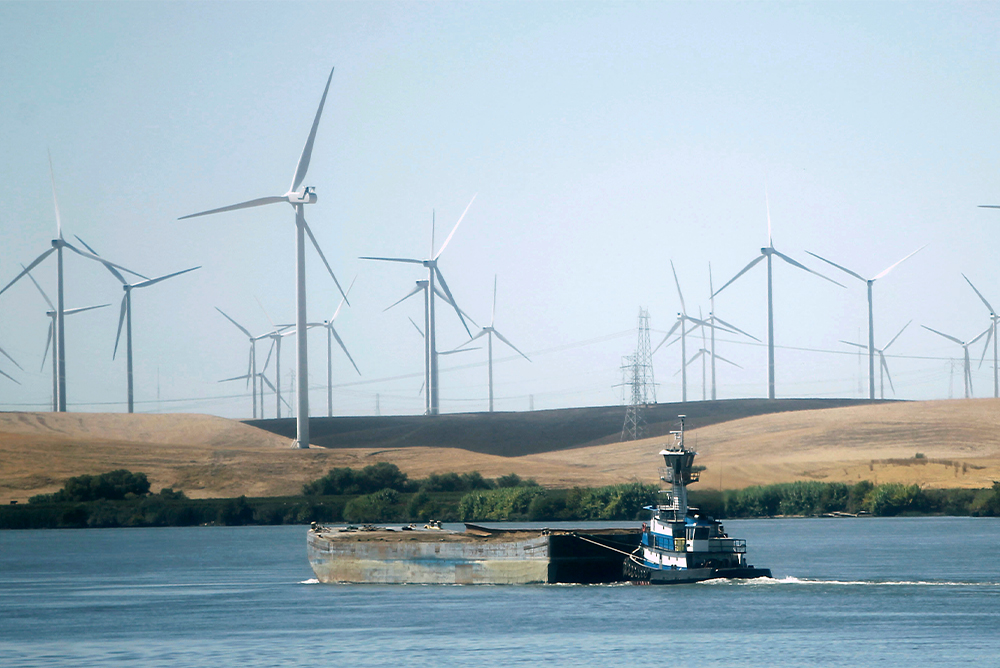
When the federal government created incentives for clean energy firms to work with communities, Castle Wind gave it a try in Morro Bay—only to lose out in an auction for wind farm leases. But the work the company did may still provide a model for the future, writes columnist Joe Mathews. Courtesy of AP Newsroom.
Do we care if climate projects make allowances for the communities they impact?
That’s the question posed by the first-ever auction for leases to create giant wind farms in the ocean off the U.S. West Coast. The auction, completed late last year, awarded rights to build vast flotillas of wind turbines 20 miles off the coasts of San Luis Obispo and Humboldt Counties.
This was supposed to be a clarifying moment in California’s commitment to wind energy. The Golden State, for all its boasting about climate change policy, has lagged behind the East Coast in developing offshore wind power. This is partly because our deeper waters require deploying giant, floating turbines. It’s also because of all the potential opposition in the state—from fishing industries, Indigenous communities, and local stakeholders. We Californians distrust changes anywhere near our beloved shoreline.
In response, the federal government established auction rules that would consider not just the amount companies bid for rights to harness the wind, but whether bidders engaged with local communities. Under the formula, companies who created partnerships with benefits for communities could earn credits to boost their bids, giving them an edge in the auction.
One bidding company did exactly that.
But was it worth the effort?
The center of this head-scratching story is Morro Bay. When offshore wind development became a public issue there nearly a decade ago, citizens reacted with skepticism and anger. They expressed concerns about how construction would impact the shore, and fears about the impacts of turbines on birds, fisheries, or, even at a distance of 20 miles from land, the views and natural beauty of the coast.
Other companies kept their distance from residents. But in 2015, Castle Wind LLC—a joint venture between Washington state-based Trident Winds and a North American subsidiary of the Germany utility EnBW Energie Baden-Württemberg AG (EnBW)—jumped in and started a dialogue with residents and stakeholders.
Local leaders advised Castle Wind to talk with fishermen first, given the struggles of that industry and the questions about how wind farms might impact fisheries. After more than two years of talking, Castle Wind, the Morro Bay Commercial Fishermen’s Organization, and the Port San Luis Commercial Fishermen’s Association forged a novel mutual benefits agreement. Completed in October 2018, the agreement offered three main benefits for fishermen: a new fund for infrastructure improvements for the commercial fishing industry, new training and employment for fishermen, and a process for the local fishing industry to help shape wind project design.
With the fishermen on board, the Morro Bay City Council subsequently approved its own community benefits agreement with Castle Wind. The company agreed to hire local residents to create internships and training programs around the wind farm at local schools and universities, to establish a project maintenance and monitoring facility in the Morro Bay harbor, and to promote local businesses.
Both agreements were popular and productive. Indeed, last year, Castle Wind and the fishermen deepened their partnership by creating a “mutual benefits corporation” as a legal vehicle for carrying out future joint projects. The body was modeled after a corporation formed more than two decades ago to protect fishing activities in California from the impacts of transoceanic fiber optic cables.
Alla Weinstein, the Castle Wind CEO who conducted the conversations, said last fall in a statement announcing the corporation: “Our approach has been to acknowledge, as early as possible, that impacts may occur…Castle Wind has created a platform for the developers to mitigate anticipated impacts of offshore wind to the commercial fishing industry without causing stakeholder fatigue.”
But when the auction was held in December, the benefits agreements and the corporation didn’t make any difference. Castle Wind, even with credits, did not win a single lease. Instead, the leases in areas off San Luis Obispo County went to three higher bidders—each of whom bid over $100 million, among them Equinor, a Norwegian state-owned oil company. None had reached agreements with Morro Bay locals, as Castle Wind had.
The auction has raised many questions about the future of climate and community. Federal officials, Castle Wind, and other bidders have been tight-lipped about the result. Locally, city officials and fishermen’s groups have expressed disappointment, and noted pointedly that the winning bidders had not forged agreements and did not have their support.
In Morro Bay, there is still considerable hope that winning bidders will approach the fishermen, the city, and other communities to execute agreements and make partnerships based on those forged with Castle Wind. That hope is based on the widespread view that Castle Wind’s agreements were thoughtful and well-drafted, and stood to benefit everyone—from the company, which wanted the lease, to the city and its fishermen, who sought to create new job and development opportunities for the city.
That hope also reflects political reality. California needs clean energy, but constructing wind farms will take years—and is unlikely to succeed if local communities and their state and federal representatives stand in the way.
Yes, talking takes time, and climate change is an emergency. But in California, if you want to build new projects to save the climate or anything else, you need the wind, and local communities, at your back.




Send A Letter To the Editors